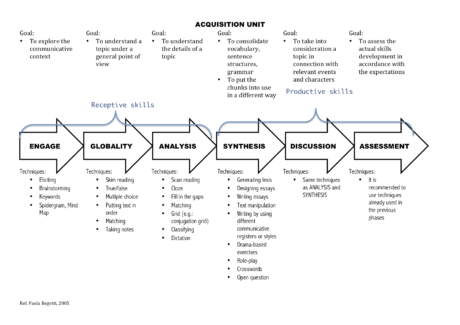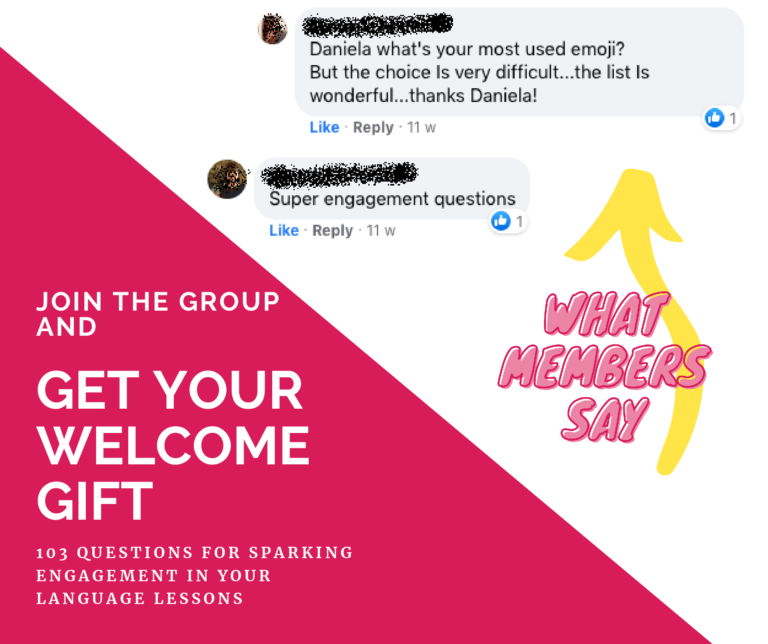
Throwing together a bunch of exercises can be a strategy if you are really in a rush and you ran out of ideas. That shouldn’t be the preferred strategy, though. In this article you are going to learn how to plan the perfect language lesson for getting your students engaged, without feeling overwhelmed or stuck. This is going to be your magic wand that allows you to plan both one-off effective language lessons and entire language courses.
The pattern for planning the perfect language lesson
Every language teacher experienced this at least once in their career: too many goals to run after, too many topics to cover, too many needs to take care of. All this, altogether, might make you feel overwhelmed and stuck. There is a simple pattern you can stick to whenever you feel stuck and you need to come up with an effective language lesson for your students. That pattern is called G.A.S. and it stands for globality, analysis, synthesis.
Nowadays, most of the textbooks for language learning based upon communicative approaches follow that pattern. That’s great news because it means you can rely on your usual textbook and make the most of it. Also, if you become aware of the pattern standing behind each learning unit, you will be able to enrich your textbook with fresh resources. Most importantly, you will be able to do this in a way that makes sense and that facilitates the learning process for your students.
Globality – first phase of the pattern
In the phase called globality we want to introduce for the first time whatever we need to teach the students (new vocabulary, grammar structures or functions, for instance). We want to do this by activating their creative and emotional brain areas in order to grab their attention straightaway. We can do this by using didactic resources such as video-clips, interesting reading texts, audio-tracks, songs, comics, plays, and so on. It doesn’t really matter what type of resource you will pick, as long as you choose something engaging and that is relevant to your students. The goal of this phase is to introduce new content for the first time. This means that your students will be getting familiar with that content. It doesn’t mean they will be memorising the new chunks of information right away. On the contrary, they will be getting an overall, global understanding of the new input. Therefore, let them enjoy the content, let them play with it! In LingoDrama method, for instance, we use a specific kind of dramatisation for introducing new content. If you are not familiar with drama approaches, go for other types of resources (such as video-clips, interesting reading texts, audio-tracks, songs, comics, etc). for teasing your students’ attention.
Analysis – second phase of the pattern
In the phase called analysis we want to breakdown the content and analyse it from a structural point of view. We can achieve this either through structured grammar/vocab exercises or through games. By games I mean structured grammar/vocab exercises turned into games. The goal for this phase is to make sure the students consolidate the meaning of the chunks. In other words, they have to take the leap from a global understanding of the content to a specific, analytical understanding of that content.
Synthesis – third phase of the pattern
In the phase called synthesis we want to encourage the students to put the new content into use. Remember: this is not an evaluation phase where we test their memory or skills. In fact, their brains are still absorbing and memorising. Your goal in this phase will be to help your students to use the new chunks creatively and, after some practice, spontaneously. The typical exercises for this phase are basic role-plays and basic creative writing exercises. In LingoDrama, for instance, we use a lot of creative writing for activating the content in a creative way. This helps the students to take the first steps in becoming self-efficient when it comes to putting the new content into use.
More than three phases in the pattern for planning the perfect language lesson
What you have just learned about is actually the core pattern of any effective language lesson. There is more than that, though. In fact, the parts of an acquisition unit are: motivation (engage), globality, analysis, synthesis, discussion and assessment (evaluation). Nevertheless, the three phases globality, analysis and synthesis are the core part of the acquisition unit. We language teachers ought to plan all our lessons by following the G.A.S. pattern.
How long should each phase last?
At the beginning of this article you read the pattern is going to be your magic wand that will allow you to plan both one-off effective language lessons and entire language courses. In fact, each phase can actually last a few minutes up to days of lesson. It really depends on the curriculum and the syllabus you need to stick to.
One step at a time is all it takes to get there.
Emily Dickinson
That said, my suggestion is to start with one step at a time. If you are not familiar with the G.A.S. pattern, it is a brilliant idea to plan your next language lesson based on that pattern. In order to help you with that (I love helping language teachers! Hi-hi-hi!) you can find more information on each phase of the didactic unit structure in the picture below (ref. Paola Begotti, 2005).

Enjoy planning effective, engaging language lessons by using your brand-new magic wand!
Want more support?
Join the Facebook group Independent Language Teachers Collective to get daily advice, tons of free training and to branch out with other independent language teachers like you!
ALSO…
Available only for the Collective members: free list 103 question for sparking engagement in your language lessons.
This is what members say about the freebie:

Join in the Collective and grab your welcome gift:
Join Facebook Group

